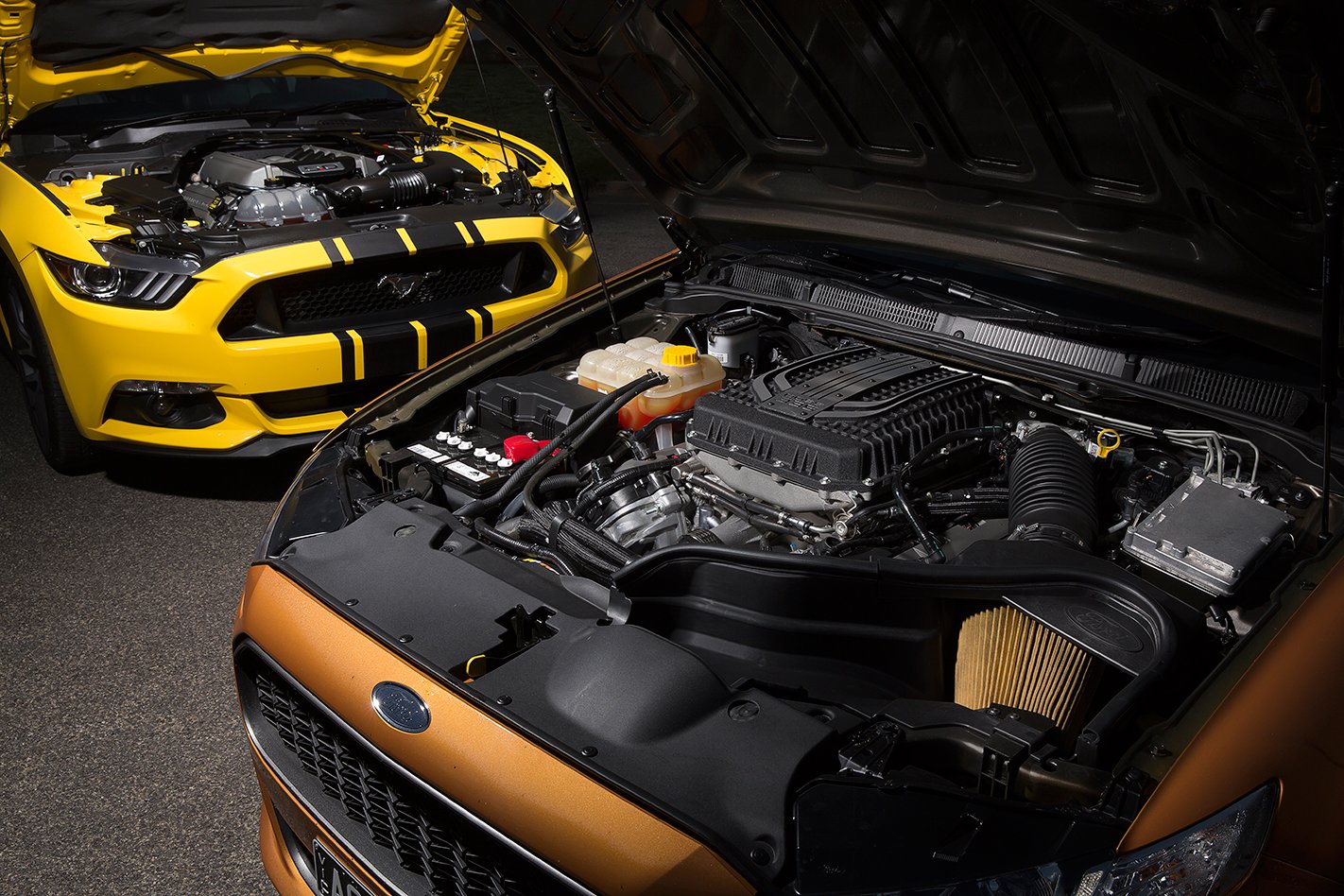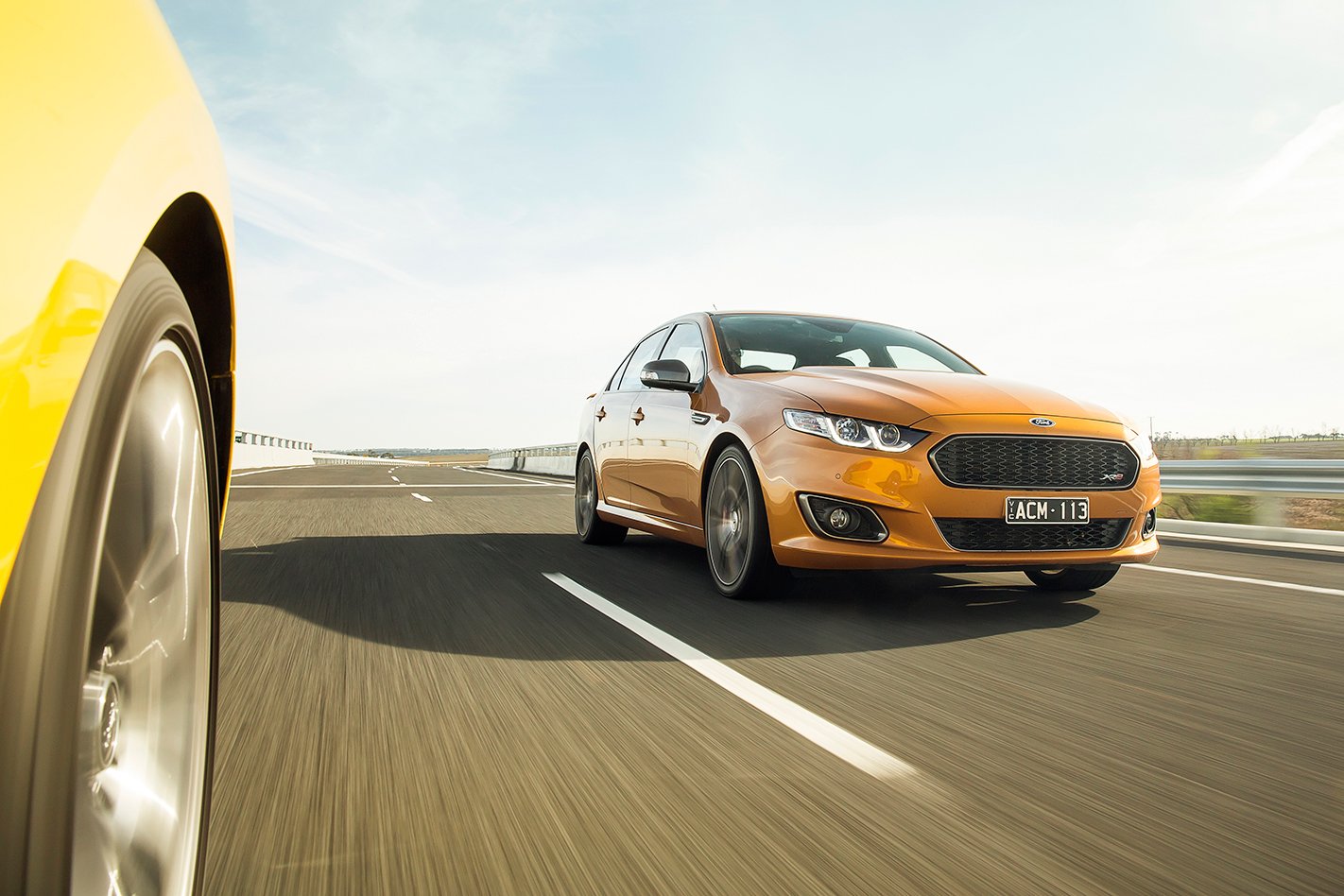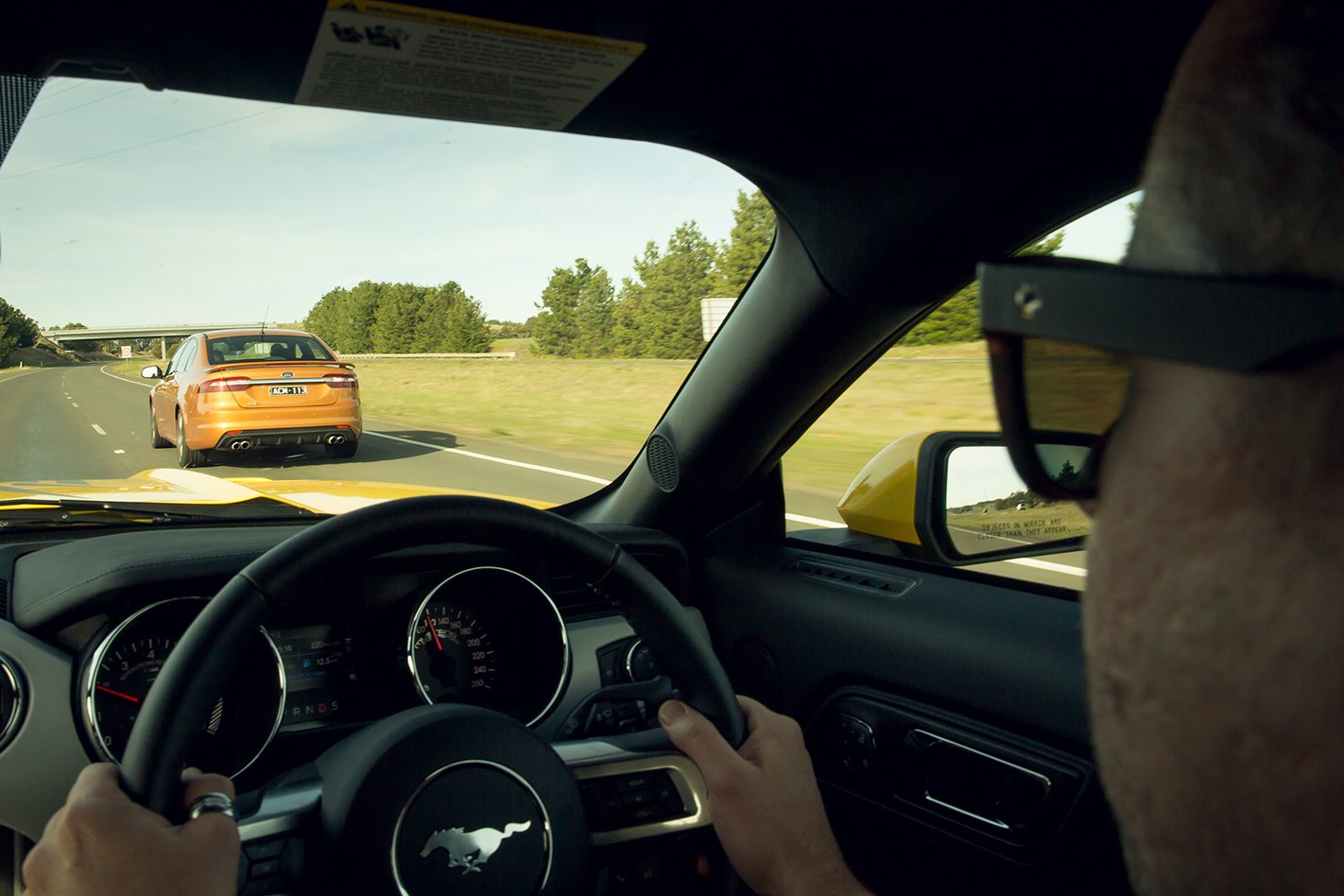BLAME Bathurst. That’s where the Aussie affair with V8 power really took shape. And that shape, when it arrived in 1967, was the four-door XR Falcon GT. Tweaked with chrome wheel trims and GT Gold paint, the XR was hailed for its “Mustang-bred styling” and, of course, the 4.7-litre Windsor V8 also wrangled from the rock-star American coupe.
If there was to be a Mustang four-door, our Ford Falcon was apparently going to be it. We’d already seen the real deal in a handful of high-profile racing Mustangs – all of them soon upstaged by Allan Moffat’s awesome 1969 Trans-Am, the most exotic of them all – but what mattered to the punter in the street was Bathurst, the showroom showdown among Series Production touring cars like you and I could buy.
Even when local pony-car coupes followed, the financial reality for most Australian families was still one car: a locally-built sedan that could have the guts, or at least some of the gloss, of a Bathurst winner. And so, to Australians, a muscle car has four doors.
Now the Falcon faces the chop at the end of 2016. That sucks, but Ford is determined to show the upside. The broad-shouldered local, currently covering roles from taxi-spec EcoLPi six through to the stonking 335kW supercharged XR8 grand tourer on this page, can hand over to two or three imported models that might better fill each niche. The first of them, arriving at the end of this year after a mere 50-year wait, is the real-deal Mustang.

But we’ve saddled-up early. This 2015 Mustang GT comes to you from Craig Dean of Mustang Motorsport, long-time converter of current-model Mustangs, Shelbys, Saleens and Ford GTs, along with hot GM and Chrysler import iron.
The Triple Yellow Tri-coat example is one of two 2015 models Dean has been quick to convert, and is therefore likely to differ in some ways from the factory-built right-hook cars.
This one’s a standard GT, carrying the 5.0-litre V8 with 324kW and 542Nm and a six-speed automatic transmission. It’s fitted with 20-inch wheels in place of (US) stock 18s. But all factory Oz Mustangs will come standard with a GT Performance Package, which brings 19-inch wheels, larger brake rotors and six-piston front calipers, a front strut brace, Torsen limited-slip diff and shorter (i.e. lower-geared) final-drive ratio.

There’s also the price. Dean’s converted example was quick to sell at $125,000. It was bought by a lively 73-year-old lady who, Dean says, has been a serial modern Mustang customer. Pricing for Ford’s Australian dealer-delivered Mustangs will range from $45,000 for the four-cylinder turbo EcoBoost to $55,000 for the V8 GT, with six-speed autos adding $2500 in both cases. Meanwhile, an auto-only Mustang Convertible will go for $64,000.
Interestingly, those V8 prices put the Mustangs only a grand upwind of the Falcon XR8, with which it will share showroom space for 12 months. We’ve brought along a Victory Gold six-speed auto XR8, keen to see how the long-legged (and large-lunged) Aussie sedan differs thematically from its American cousin.
The Falcon is so warmly familiar: the full five-seater comfort, the high-riding vision, the relaxed way in which the blown ‘Miami’ V8 cranks on the turn of the key and responds to the first prod of the throttle. Got 335kW in here, mate. Nothin’ to prove. But if you wanna step outside…

How’s this for irony: When the US Falcon died in 1970, the Aussie Falcon set off on its unique path and thrived. And 45 years later, as the axe was suddenly raised over the Falcon, the Mustang marked its 50th anniversary with a whole new lease of life.
Throughout its career, the Mustang had lagged behind – and well behind Falcon – with antiquated, live-axle underpinnings. Thankfully, the engineers finally beat down the bean-counters and, while retaining the wheelbase of the landmark 2005 “retro” Mustang, endowed the 2014 car with a new, multi-link rear end. This begat a largely new strut front end, new subframes, brakes, the whole nine yards. It’s said they initially experimented with the Falcon’s Control Blade IRS, adapted here in Oz from its European front-drive origins. Mustang instead ended up with an ‘integral link’ set-up, derived from the Ford Fusion.
The Falcon-Mustang relationship is nothing like the intimate Commodore-Camaro kinship over at rival GM. About all the Fords evidently have in common are a 5.0-litre V8 (the atmo Stang just 11kW and 28Nm shy of the XR8’s blown version), the carryover SYNC2 cockpit touchscreen display and front seats that look similar but, er, aren’t.

Nope, the Mustang’s influence is all Mustang. So much so that the only Ford logo you’ll notice, eventually, is the one in the windscreen epoxy near the interior mirror. The iconic fastback shape appears initially not so different from the ‘retro’ of 2005 – in turn, recalling the 1969 Mach 1 fastback – but it’s notably lower, wider and edgier in every area.
On the road, the Mustang has a Transformer-bot presence, a bad-assness that’s thoroughly modern-American. I was trying to fit it to one or another of the modern Marvel Comics movie characters, when Commissioner Gordon projected the Mustang spotlight onto the ground near my feet.
The view through the windscreen says much about Mustang’s global ambitions: the long, thrusting bonnet is a classic pony-car cue, but its ridges and reverse-angles seem to whisper in Lamborghini language.

Inside, there are several design conversations going on, with German seat styling, American pony-car asymmetric dash top, Italian torpedo-tube instruments, latest-gen Asian HVAC controls and, below that, four toggle switches reminiscent of the Ford GT40. Various fake metals also interact.
Materials quality ranges from superb, as on seats and door trims, to sorta sketchy, like the plastic on the A-pillars. The minor controls still feel more Ford than Ferrari.
The front seats are as supportive as they look, and whirr back and forth to ease entry and exit. There’s a huge range of seat adjustment, and the slightly oversize steering wheel offers height and reach adjustment. The spacious cockpit includes you as a coupe should.

Rear seat occupants get a rougher deal. There’s just enough foot and knee room back there, but heads are squished against the rear glass. With fixed windows, no grab handles and awkward access, it’s definitely a 2+2 coupe rather than a Falcon fastback.
The console-mounted Start button, at least in this converted car, is obscured by the gear knob. The exterior mirrors, too, are annoyingly small. But from the very first rumble through the exhaust, the Mustang has a feeling of focus, a hard edge that’s long been muted in the tool-for-all-tasks Falcon.
The Mustang’s atmo V8 is truly responsive underfoot; its 542Nm is nothing to sneeze at, and the coupe’s kerb weight of 1728kg is about 130kg less than the four-door Falcon. The Mustang’s Ford-built six-speed auto exploits it with a Sport slot at the base of the gate and steering-wheel-mounted paddles. It’s more involving than the Falcon ZF unit’s parallel manual gate.

Stomping the Stang really does bring a sensation of the pony car’s hot-rodding roots. The long bonnet rears up (cue sound effects of horse whinnying), massive forces hook up deep in its bowels and the coupe lunges forward, the squirming rear end adding to the theatre. It’s refined, it’s efficient, but it’s still there. If this was a manual, I reckon I’d be in danger of throttle-blipping on the upshifts, Bullitt-style.
A traditional American muscle car would still be sitting there, smoking tyres and axle-tramping its diff through the floor. An Aussie V8 would impart only half the idiot-grin factor. But the Aussie sedan would be running right alongside the Mustang. The XR8’s acceleration figures all the way to 160km/h and across the 400-metre mark remain consistently within three-tenths of a second of the supposedly thoroughbred coupe’s.
Numbers on paper are about all there is to compare. The tight-bodied Mustang shows the XR8 as a fits-all family sedan engineered down to a price, then geniused-up to an effortless, highway-hoovering grand tourer. That tradition – and forgive us a little romance, for it’s well warranted – really does trace a line straight back to famous forebears like the XY GT-HO Phase III.

Just consider the Falcon XR8, in this final FGX guise. While we’re gushing about the Mustang and its incredible value, here’s a 335kW supercharged V8 available in either six-speed manual or auto, a full five-seater executive express that’ll do low-13sec quarters, at about $55K.
The XR8 acquits itself pretty well through the twisties, too, though the steering feel is lazy and bouncy, and the chassis never seems to truly hunker down. As Ponch has previously observed so accurately, you always feel you’re sitting on the Falcon, rather than really in it.
The XR8 doesn’t immediately feel that quick – until you’re suddenly going really quickly. The big sedan takes a fraction longer to shift its bulk off the line: auto for auto, the Falcon doesn’t have the kick of the toey Mustang, and can’t quite match its 0-100km/h time. After that, though, the four-door hits its stride, and comfortably surges forward.

The XR8 feels like it was built to do 180km/h all day on the Hay Plain. It’s not hard to imagine Ford Australia’s test engineers chuckling knowingly to each other at that, but there’s debatable logic in engineering a car to excel at 180km/h in our over-policed nanny nation. It’s not that Ford Australia had its sights set on exports to Germany; rather, the flattened response to initial throttle inputs, the long, lazy pedal travel and an eager (but seamless) ESC system hint strongly at having to rein-in power for a chassis not truly up to it.
Why, the next-nearest thing in the Ford catalogue to the XR8’s 335kW is, or soon will be, a purpose-designed performance coupe. And the Mustang has few compromises – at last – with a palpably tight body, a truly well-controlled and comfortable (if firm) ride and, certainly in this standard guise, a surprising measure of nuance to its handling.
Aided immensely by this car’s Pirelli P Zero 265/30R20 rubber (same size front and rear; the Oz 19s will be staggered sizes), the Mustang on its standard suspension left us wanting for little in its combination of turn-in urgency, cornering balance and feedback. The chassis really rips into a corner, the quick steering prompting a perceptible weight shift in the rear. But braking into corners is mighty, grip is abundant, and the Mustang just digs a furrow through the corner, inspiring huge confidence.

It still feels a bit heavy when changing direction, but it’s not the blunt instrument you might expect. It makes you want to go and find a Toyota 86 and push it over in the playground.
The steering offers three settings: Normal, Sport and Comfort. While never achieving Porsche-like levels of feel, Normal mode provides a sneeze-factor at centre and a cheek-slapping turn-in. Sport mode adds more linear response from centre and more weight, even to a slightly leaden extent. We kinda preferred Normal.
Our American correspondent Aaron Robinson reports that their standard GT is a little soft and drifty, but the US cars wear lower-spec, all-season Pirelli P Zero Nero 19s. Given the way our car’s 20s allowed the suspension’s subtlety and body control to shine through, we hope it bodes well for an Australian-spec GT with Performance Package on 19s.

Indeed – and we didn’t expect to be saying this of a Mustang – we’re itching to try the EcoBoost four-banger. Ford has yet to publish kerb weights in Oz-spec, but the turbo four is believed to be about 100kg lighter than the V8.
If you want a Ford V8 performance car, put it this way: the Mustang is a far better Mustang than the XR8 is, or than any high-performance Falcon ever has been. The two nameplates went their separate ways a long time ago, and our performance sedans have changed their theme since, evolving from base-spec, big-engined Police-pack specials to luxury sports sedans.
Let us never forget, when the sun goes down on 2016, that for covering vast distances, carrying five folks and dishing out massive bang for the buck, nobody in the world has done it better.

SPECS Model: Ford Mustang GT Engine: 4951cc V8 (90°), dohc, 32v Max power: 324kW @ 6500rpm Max torque: 542Nm @ 4250rpm Transmission: 6-speed automatic L/W/H: 4783/1915/1382mm Wheelbase: 2720mm Kerb weight: 1728kg 0-100km/h: 4.6sec (claimed) Fuel economy: 13.1L/100km (test average) Price: $125,000* On sale: December *Converted car by Mustang Motorsport
Model: Ford Falcon XR8 Engine: 4951cc V8 (90°), dohc, 32v, S/C Max power: 335kW @ 5750rpm Max torque: 570Nm @ 2200-5500rpm Transmission: 6-speed automatic L/W/H: 4949/1868/1458mm Wheelbase: 2838mm Kerb weight: 1861kg 0-100km/h: 4.9sec (estimated) Fuel economy: 12.8L/100km (test average) Price: $54,690 On sale: Now
Mustang Motorsport
CRAIG Dean’s passion for US muscle cars began when his dad gave him a Camaro. After a stint in the RAAF as a mechanic, Dean set up Crossover Car Conversions in 1990. The Ferntree Gully (Melbourne) hot shop kicked off with Camaros, but now fettles Corvettes, Dodge Challengers, Vipers, Ford GTs and F-series trucks.
“Nobody was doing Mustangs right,” Dean says of starting the offshoot, Mustang Motorsport. As well as being the only accredited Shelby modifier outside the US – he also carries Roush performance gear – Dean ponies-up for tarmac rallies in his own supercharged 2006 Saleen S351.
Aussie Mustangs
WHEN the new Mustang lands at the end of this year, it will be a mere 50 years since Ford Australia first officially imported the nameplate. In July 1965, just over a year after the Mustang’s debut at New York’s World Fair, Ford Oz imported 48 examples and had them converted at its Homebush plant in Sydney.
The arrival of the “Mustang-bred” XR Falcon in ’66 prompted a further batch of Mustangs that year. It’s believed that all the Oz Stangs were hardtop coupes, and 4.7-litre automatics. Ford Australia then engaged in an ill-advised program in 2001 that saw the already ageing fourth-generation model brought here and converted by Tickford (the predecessor to FPV). The expensive – $85K for the coupe – and underperforming model quickly disappeared without a trace.





